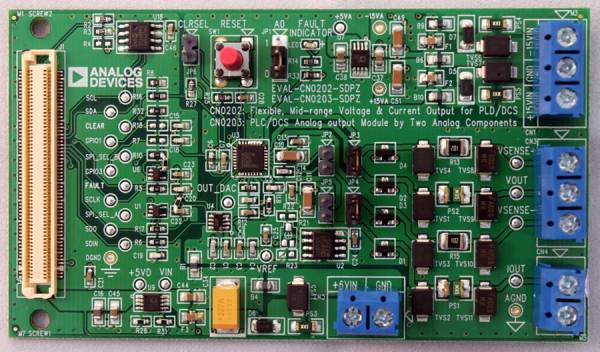
CN0203 is a full function, flexible, programmable analog output solution with only two analog components and meets most requirements for programmable logic controller (PLC) and distributed control system (DCS) applications. It provides all the typical current and voltage output ranges with 16-bit resolution and no missing codes, 0.05% linearity, and less than 0.1% output error. Furthermore, it also contains key features for industrial applications, such as on-chip output fault detection, CRC checking to prevent packet error (PEC), and flexible power-up options, making it an ideal choice for robust industrial control systems. No external precision resistors or calibration routines are needed to maintain consistent performance in mass production, thereby making it ideal for PLC or DCS modules.
The AD5750-1 are single-channel, low cost, precision voltage/current output drivers developed to meet the requirements of industrial process control applications. The voltage output range can be programmed for the standard output ranges for PLC and DCS applications: 0 V to 5 V, 0 V to 10 V, −5 V to +5 V, and −10 V to +10 V. A 20% overrange setting is also provided for the standard ranges, giving the following options: 0 V to 6 V, 0 V to 12 V, −6 V to +6 V, and −12 V to +12 V. The current output, which is provided on a separate pin, can be programmed for the ranges of 4 mA to 20 mA, 0 mA to 20 mA, −20 mA to +20 mA, 0 mA to 24 mA, and −24 mA to +24 mA. The unipolar ranges have a 2% overrange setting. The voltage and current output pins can be tied together to configure the end system as a single-channel output if desired.
The AD5660-1 is a single channel, low cost, low power, rail-torail voltage buffered output nanoDAC integrated with an onchip 1.25 V, 5 ppm/°C reference. The AD5660-1 incorporates a power-on reset circuit to ensure that the DAC output powers up to 0 V and remains there until a valid write command takes place. The output voltage range of the AD5660-1 is 0 V to 2.5 V, which matches the input range of the AD5750-1. In addition, the reference output voltage of the AD5660-1 is 1.25 V, which precisely matches the reference input requirement of the AD5750-1.
The CN0203 needs +15 V, -15 V and +6 V power supply inputs and thus, needs a triple output DC power supply. The board also connects to ADI's System Demonstration Platform (SDP).


Power on the (EVAL-CN0203-SDPZ) through the triple output power supply and the (SDP-B Board) through the PC SEPARATELY before connecting the two boards together.
See the table in the image below for the jumper settings. Values in red are the default settings for the EVAL-CN0203-SDPZ.

NOTE: It is recommended that you install the CN0203 Evaluation Software to the default directory path C:\Program Files (x86)\Analog Devices\CN0203\ and all National Instruments products to C:\Program Files\National Instruments\




NOTE: It is recommended that you close all other applications before clicking “Next”. This will make it possible to update relevant system files without having to reboot your computer.

It is recommended that you install the drivers to the default directory path
C:\Program Files\Analog Devices\SDP\Drivers




EVAL-CN0203-SDPZ Design & Integration Files
Receive software update notifications, documentation updates, view the latest videos, and more when you register your hardware. Register to receive all these great benefits and more!
End of Document